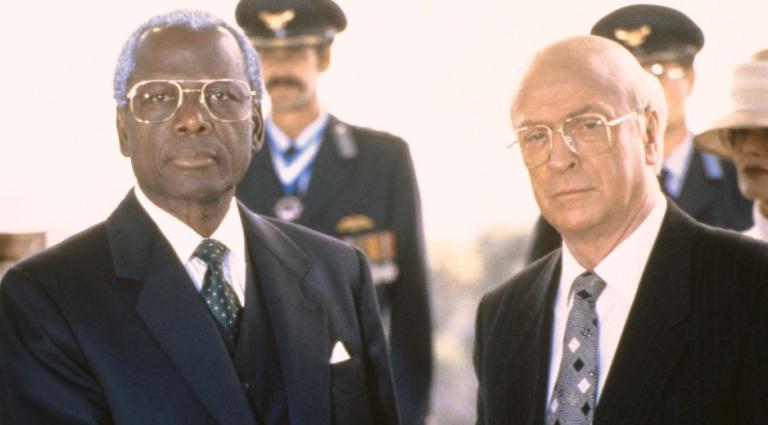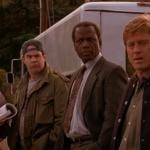The last in a month-long series of re-posts from my Facebook marathon in April 2020.
–
Sidney Poitier marathon part 22 (1997):
Mandela and De Klerk (1997) wasn’t quite the first TV-movie about Nelson Mandela, but it was, I believe, the first one to be made after he was released from prison in 1990.
Danny Glover had starred in a 1987 TV-movie called Mandela, but, at that time, there had been no new public images of Mandela himself since his imprisonment in the early 1960s. So Poitier was the first actor to play Mandela after the public had gotten a chance to familiarize itself with the way Mandela looked and spoke “today” — and Poitier took the role mere months after Mandela was elected president of South Africa in 1994.
The two-hour film spans the 30-plus years from Mandela’s imprisonment to his eventual election, but it compresses the bulk of that period into the first half of its runtime so it can devote the second half to the years immediately before and after Mandela’s release. And there’s an interesting shift in the movie’s tone between those two halves.
For the first hour, Mandela adjusts to life in prison and is treated fairly well by the guards etc., while politician F. W. De Klerk (played by Michael Caine) kind of admires him from afar and quietly opposes the more draconian measures inflicted on the populace by President Botha. But once De Klerk becomes president himself and begins to negotiate with Mandela on how to end apartheid and set him free, things grow tense.
As in most movies of this sort, the main focus is on the dialogue, as characters lay out the various political issues that are at stake. It feels a bit like a history lesson cobbled together from newspaper editorials and the like. (The repeated use of archival news footage contributes to this feeling.) But Poitier and Caine deliver the dialogue as well as can be expected.
As they say, journalism is the first draft of history, and, while this movie isn’t a work of journalism per se, it makes sense that this early attempt to dramatize the end of apartheid feels more like a journalistic summary of recent events than the deeper plunge that could have come from having more of a perspective on this moment in history.
A few other quick points:
— This was the third time Poitier played a contemporary real-life person, following his portrayals of Inman Jackson in 1954’s Go Man Go and Thurgood Marshall in 1991’s Separate but Equal.
— This was also the third time Poitier played a South African, following 1951’s Cry, the Beloved Country, in which he played a priest, and 1975’s The Wilby Conspiracy, in which he played a revolutionary. (Cry, the Beloved Country was based on a book that came out shortly before apartheid began in 1948, so you could say that Poitier starred in films that take place before, during, and after that period in South African history.) He also played a Kenyan revolutionary in 1957’s Something of Value, and a political leader in an unspecified African country in 1957’s The Mark of the Hawk.
— This might be the first film in which Poitier played older than his actual age. The second half of the film takes place when Mandela is in his 70s — he was 71 when he was released from prison and 76 when he was elected president — and Poitier was 69 when the film was shot. (Reportedly Poitier lied about his age when auditioning for the part of the young doctor in 1950’s No Way Out; he was 23 at the time, but I don’t believe the doctor’s age is specified within the film.)
— Earlier Poitier films, like 1973’s A Warm December and 1975’s The Wilby Conspiracy, underlined the Marxist and/or Soviet element in revolutionary and post-colonial African movements. This film makes a point of noting that the South African government thought the Western countries would tolerate South Africa’s policies if South Africa was an ally in the fight against Communism — and the film hints that apartheid finally ended because the Cold War ended. Without the Soviet threat, the South African government could no longer use anti-Communism to justify its treatment of Mandela and his movement.
— The real-life Mandela was president of South Africa from 1994 to 1999. Curiously, this appears to have been the only major film about him made during that time. But there were several films about him afterwards, most notably between 2009 and 2013, when he and his wife Winnie were the subject of no fewer than six films starring the likes of Morgan Freeman (2009’s Invictus), David Harewood (2010’s Mrs Mandela), Terrence Howard (2011’s Winnie Mandela), Idris Elba (2013’s Mandela: Long Walk to Freedom) and Clarke Peters (2009’s Endgame and 2013’s Mandela: The Prison Years). Other actors who have played Mandela include Lindane Nkosi (2004’s Drum), Dennis Haysbert (2007’s Goodbye Bafana) and Laurence Fishburne (2017’s Madiba).
— Reunions: Poitier and Caine previously co-starred in 1975’s The Wilby Conspiracy, which was also set in South Africa. Also, this film was directed by Joseph Sargent, who had been the original director on 1972’s Buck and the Preacher before Poitier replaced him. (This film also marked the third time that Caine and Sargent worked together, following 1987’s Jaws: The Revenge and 1994’s World War II: When Lions Roared, in which Caine played Josef Stalin!)
After this, Poitier made one last appearance on the big screen.
The Jackal (1997) is a very loose remake of 1973’s The Day of the Jackal, in which Bruce Willis is hired by some Russian mafia guys to assassinate an American, and Richard Gere is a prisoner with ties to the IRA who once met Willis and is hired by the FBI to help track Willis down.
Poitier plays the FBI deputy director who gets Gere involved, and there’s not much more to his role than that. Poitier got his career off to a great start as the central figure in 1950’s No Way Out — an unusually strong role for a big-screen debut — but his big-screen career ended with this virtually anonymous paycheque gig. He still had a few TV-movies in his future, but that was it.
A few other quick points:
— This might be the first Poitier film since 1965’s The Greatest Story Ever Told that did not put his face on the movie poster. And he had only a cameo in that other film.
— Time capsule, politics edition: The opening credits play out over a montage that covers the rise and fall of the Soviet Union. The film also came out three years after the IRA ceasefire in 1994. And Poitier’s character comments that a female Russian colleague of his is so good at what she does that she ends the debate on women in combat, as far as he’s concerned; this film came out just one year before 1998’s G.I. Jane, which also reflected the debate around that issue.
— Time capsule, technology edition: Willis tells the guy who hired him not to communicate with him by phone or fax. He later visits an internet cafe (remember those?) and uses its dial-up modem to check his messages. He later buys a boat, and the salesman notes that the boat “even has a cellular phone. You can call your wife if you want to!” I got my own first cell phone in 1999, two years after the movie came out, and before most of my friends had gotten one.
— One scene focuses on the fact that security at the Canadian-American border is very lax. One agent says something like, “You don’t need a Houdini to get into Canada, he could probably walk in!” As I recall, the first time border agents started insisting on seeing my passport when I made short trips south of the border was after 9/11 happened, four years after this movie came out.
— Up-and-coming actors: J.K. Simmons plays an FBI agent, Jack Black plays a black-market merchant of sorts who is killed rather gruesomely after he tries to extort some extra money out of Willis, Daniel Dae Kim plays a sniper, and Sophie Okonedo plays an anonymous “Jamaican Girl”.
— This time in LGBT references: Willis meets a guy at a gay bar, kisses him (which was unusual for a star of Willis’s stature at the time), and uses his home as a base of sorts, after killing him.
— As in 1988’s Shoot to Kill, so here: Poitier plays an FBI man who pursues a criminal on both sides of the Canadian-American border — this time on the east coast, rather than the west.
— I happened to visit Montreal and Washington, DC for the first time just a month or two before this film came out, so I was kind of tickled to see that the story itself straddles those two cities. Even better, I remember really, really liking the Washington subway stations when I visited that city, and the film’s final chase scene takes place there. (Poitier, alas, does not play a part in that scene. If he had, it might have been a nice callback to the chase through an unfinished San Francisco station in 1971’s The Organization.)
— The gaps between Poitier’s final feature films were fairly long. After the one-two comeback punch of Shoot to Kill and Little Nikita in 1988, the next big-screen Poitier film, 1992’s Sneakers, did not come out until four and a half years later. Another five years passed before Poitier made The Jackal, which turned out to be his final big-screen film.
–
And that was the end of my Sidney Poitier marathon in April 2020.
Poitier starred in four more films, all for television — Free of Eden (1998), David and Lisa (1998), The Simple Life of Noah Dearborn (1999) and The Last Brickmaker in America (2001) — but I could not find three of them anywhere online, so, since I hadn’t checked out any of Poitier’s TV work in the 1950s either, I figured I would let the marathon end with his final feature film.
Poitier went on to receive an Honorary Oscar in 2002 — and that, coincidentally, happened to be the same year that Denzel Washington followed in Poitier’s footsteps by becoming the second black man to win the Oscar for lead actor (for Training Day), and it was also the same year that Halle Berry became the first black woman to win the Oscar for lead actress (for Monster’s Ball).
Poitier made history in his half-century on the big screen. And history continues to be made.
–
The image above shows Sidney Poitier and Michael Caine in Mandela and De Klerk.














